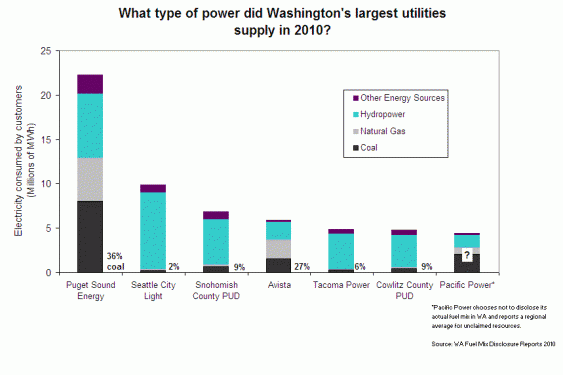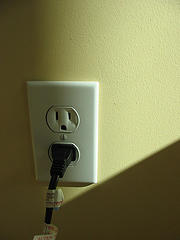This is the tale of two electrical outlets—one that gets an impressive chunk of its power from clean, climate-friendly sources, and another that channels a significant share of its electricity from polluting coal plants.
Funny thing is, the outlets are just a block away from one another.
Thanks to a law that requires utilities in Washington State to disclose where their power comes from, we know quite a bit about how different electricity providers compare. The state’s numbers have their quirks, but they do provide a consistent way for customers to evaluate their utilities’ climate performance.
Those numbers reveal two surprises. First, even though many northwesterners assume that all of the region’s electricity comes from clean hydropower, in reality 18 percent of the state’s power last year came from dirty coal plants. And second, nearly half of that polluting coal power came from a single utility: Puget Sound Energy.
For a larger version of this chart, click here.
So let’s get back to those two electrical outlets.
In Lake Forest Park, someone who flips the switch on their coffeepot each morning gets their electricity from Seattle City Light. More than a decade ago, the utility faced a fundamental choice. It owned a stake in the Centralia coal plant, the only coal plant operating within Washington’s borders and the state’s largest single source of greenhouse gas pollution. It was a cheap source of energy, but the other costs were high: climate-damaging pollution, haze that obscures our views of Mt. Rainier, and trouble for asthma sufferers. And the plant’s owners were facing a deadline to invest hundreds of thousands of dollars to install new equipment to reduce air pollution. So City Light and other utilities decided that would be a good time to get out of the business of burning coal.
Seattle City Light sold its stake in Centralia in 2000. The decision later sparked controversy, because the utility wound up paying a lot to replace that power. But in the long run, the decision looks pretty smart, given a recent decision brokered by Washington’s governor to shut down the Centralia coal plant. In 2010, Seattle got only 2 percent of its power from dirty coal sources, according to the latest fuel mix reports, all through purchases on the spot market.
Now let’s consider how a coffeepot is powered one block away in Kenmore, WA, a city served by Puget Sound Energy.
Like Seattle City Light, Puget Sound Energy has a well-deserved national reputation for supporting clean, renewable power sources. The utility is now the second-largest generator of wind power among privately-held US utilities, and also runs an award-winning Green Power Program that allows customers to pay a voluntary premium for renewable electricity. (Note: Because the utility sells “RECs,” the green attributes from its wind and solar farms, to other utilities and because the green power program isn’t considered part of their base load, they are not able to take credit for that renewable energy in Washington’s fuel mix reports.)
Nevertheless, PSE’s overall electricity portfolio remains heavily reliant on dirty coal. According to the state’s latest fuel mix disclosure report, 36 percent of PSE’s power came from coal in 2010, the bulk of which came from the Colstrip plant in eastern Montana. Colstrip is the second largest coal plant west of the Mississippi River, capable of producing more energy than the Hoover Dam, or Washington’s Centralia coal plant and Oregon’s Boardman coal plant combined. Roughly a third of Colstrip’s emissions—some 6 million tons of carbon dioxide last year alone—can be traced to PSE’s ownership. In fact, according to EPA and state data, PSE’s Colstrip emissions accounted for roughly a quarter of all climate pollution coming from the state’s electric utilities.
The chart below shows how PSE’s coal-fired power—in black and gray—compares with other major utilities in the state.
 To see a larger version of this chart, click here.
To see a larger version of this chart, click here.
And here’s a closer look at the details of the power portfolios for the state’s largest utilities:
 To see a larger version of this chart, click here.
To see a larger version of this chart, click here.
As the state’s largest utility, with more than a million electric customers from Bellingham to Olympia to Cle Elum, PSE has an outsized impact on the state’s electricity profile. And its heavy reliance on coal has a huge impact on the state’s overall emissions.
But PSE may soon face a decision much like the one that Seattle City Light confronted a decade ago. Complying with pending regulations to better control air toxins, coal ash, and regional haze that affects national parks could cost Colstrip’s owners hundreds of millions of dollars. Choosing the pathway that Seattle City Light took—by divesting itself of its stake in the polluting Colstrip plant—would truly put Puget Sound Energy at the forefront of clean energy leaders in the US.
So when PSE has to decide how invested it wants to be in the future of Colstrip, which utility will show up? The one with the biggest carbon footprint in Washington? Or the clean energy champion?
Stay tuned to find out.
Notes: Utility consumption data in this post comes from Washington State’s Utility Fuel Mix Reports. Aggregate data for the state of Washington in 2010 was supplied by the state Department of Commerce. Emissions data for the Colstrip plant in 2010 comes from the EPA’s Clean Air Markets database, and 2010 emissions data for all Washington comes from aggregate data supplied by the state Department of Commerce.
The consumption from owned coal resources that PSE reported to the state for 2010 (5.9 million MWh) and the utility’s share of the Colstrip generation data in the EPA database (5.7 million Mwh) were within 5 percent of each other, making the two sources relatively comparable. I calculated PSE’s Colstrip emissions by multiplying emissions data in the EPA database by the utility’s ownership stake in each unit (50 percent of units 1 and 2 and 25 percent of units 3 and 4). I compared this with the carbon dioxide emissions from all the electricity consumed in Washington in 2010 to arrive at PSE’s percentages of total electricity sector emissions.
*Washington’s Fuel Mix Disclosure program allows a utility to accept a fuel mix based on a regionwide pool, rather than reporting its actual fuel mix. Pacific Power was the only utility to take advantage of this provision in 2010, which likely makes the utility’s Washington fuel mix look cleaner than it actually is. For instance, the utility reported in Washington that it got 47 percent of its power from coal plants. In Oregon, Pacific Power has reported that it gets 63 percent of its power from coal. If we presume that is a more accurate reflection of the utility’s true fuel mix in 2010, Pacific Power would account for 17 percent of all the coal consumed in Washington and all other utilities combined would account for 12 percent. PSE’s percentage would remain the same, based on the utility fuel mix reports.



Comments are closed.